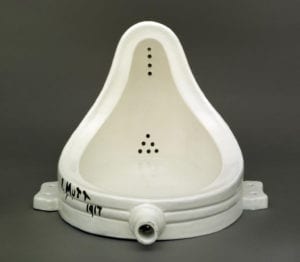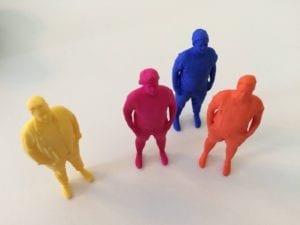What Isn’t Art?
 This was published in the July 2015 issue of Nashville Arts Magazine
This was published in the July 2015 issue of Nashville Arts Magazine
by Rachael McCampbell
Years ago, I walked into a Los Angeles gallery and saw a pile of clothes in the middle of the floor. I remember asking myself, is that art? I had to step out of the formulaic art box in my brain labeled “Art = Painting + Sculpture,” and step into the world of conceptual (and installation) art. I think the concept was a statement against rampant consumerism in our society—ironic since there was a large price tag attached, which presumably would lead to the artist and dealer buying more stuff. Regardless, my friends and I stopped to discuss the piece’s meaning, which I imagine was what the artist wanted—to create conversation. But is this art? Since this installation evoked both an important idea and feeling, I would say based on Merriam-Webster’s definition of “art,” it was.

Marcel Duchamp, the grandfather of conceptual art, shocked the world with his “Readymades.” When he attempted to display a urinal in 1917 called Fountain, Duchamp said he wanted to “shift the focus of art from physical craft to intellectual interpretation.” Robert Rauschenberg’s famous Erased de Kooning Drawing, 1953, illustrated the fact that art didn’t need to be an object but an idea.

For the Love of God, by Damien Hirst
The post-conceptual artist Sherrie Levine, best known for her Appropriation Art and for rephotographing Walker Evans’ quintessential portraits, brought up the questions of ownership of publicly viewed images, which has lead to numerous lawsuits by other Appropriation artists.
Currently we have the neo-conceptual artists like Damien Hirst, best known for preserving dissected animal carcasses in formaldehyde and encrusting a scull in diamonds. His conceptual ideas, often controversial, have made him the richest living artist in the world today.
I wanted to get a current perspective on conceptual art from an artist fresh out of school, so I spoke with Liz Clayton Scofield, a performance artist who earned an undergraduate degree from Vanderbilt and a MFA from Indiana University. “Conceptual artists often make work to participate in conversation with contemporary art and other artists. While I personally strive to make layered conceptual work, I also want to make my work accessible to the public.”
Being a working artist who survives on the sale of my art, I had to ask the obvious question, how do you make money being a conceptual artist when it doesn’t involve making objects? “Artists have their ways of surviving. Some get support through honorariums or grants, sales of video art, prints, etcetera, or even objects like my LiZes.”

LiZies, by Liz Scoffield Clayton
They are toy sculptures of the artist—an aesthetic outcropping of a multi-media project called, Making Myself, Selling Myself, Playing with Myself. ‘The LiZes follow my desire to investigate how I give myself value from my position at the margins of society as a queer trans person, while introducing an element of fun since the LiZes are meant to be played with as any toy.”
So where will conceptual art take us in the future? Will painting and sculpture become irrelevant? Will the power of an idea finally make art nothing more than an artist’s statement written on a piece of paper? I think that art reduced to an idea is only as good as the idea itself. But if making a statement, important or not, is considered art, then the next obvious question to me is, what ISN’T art?
To see the online version of this article in my column entitled And So It Goes… please go to Nashville Arts Magazine.
Leave comments here on my website. Thanks so much, Rachael

Very well written – and thank you for taking on the subject!